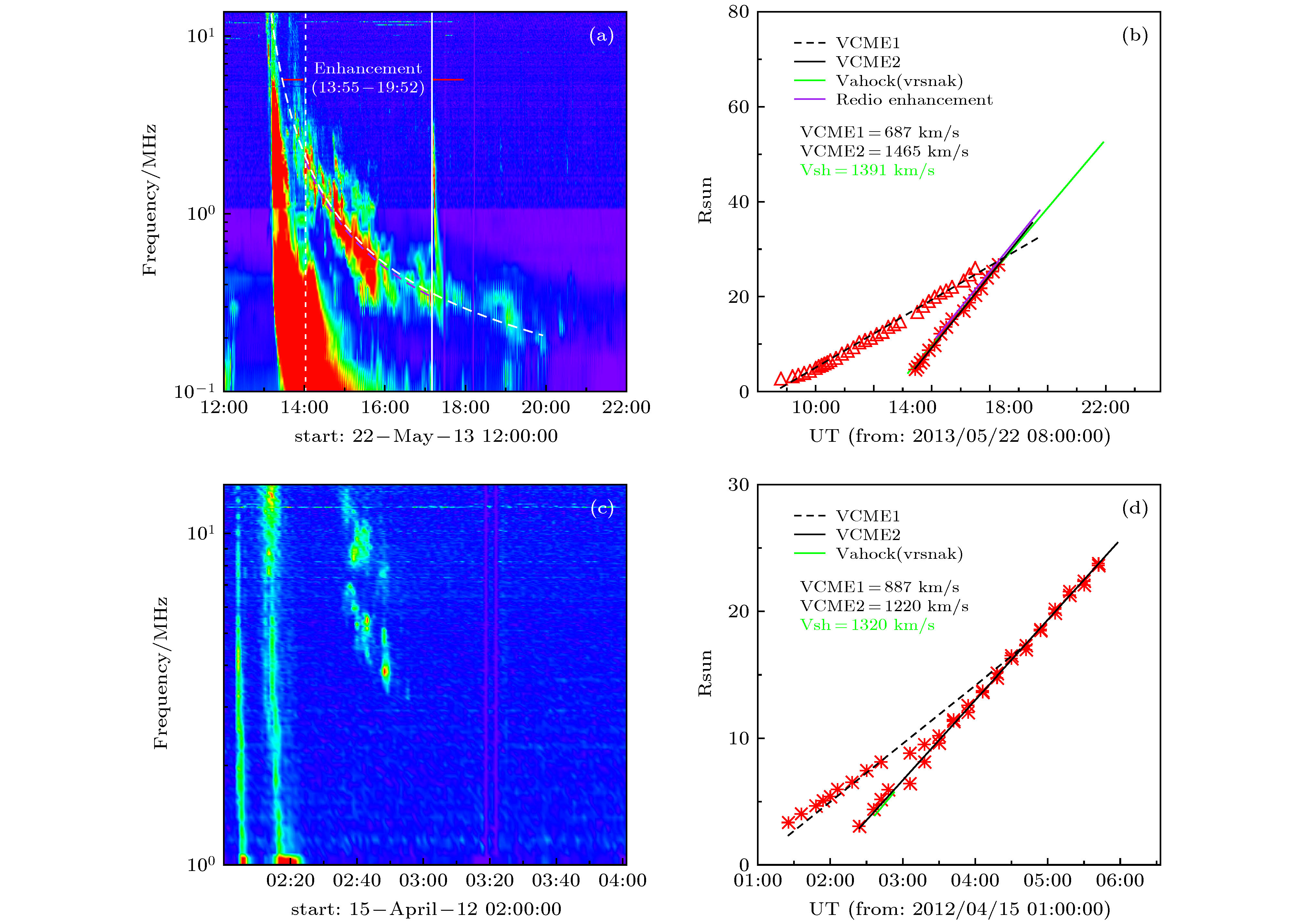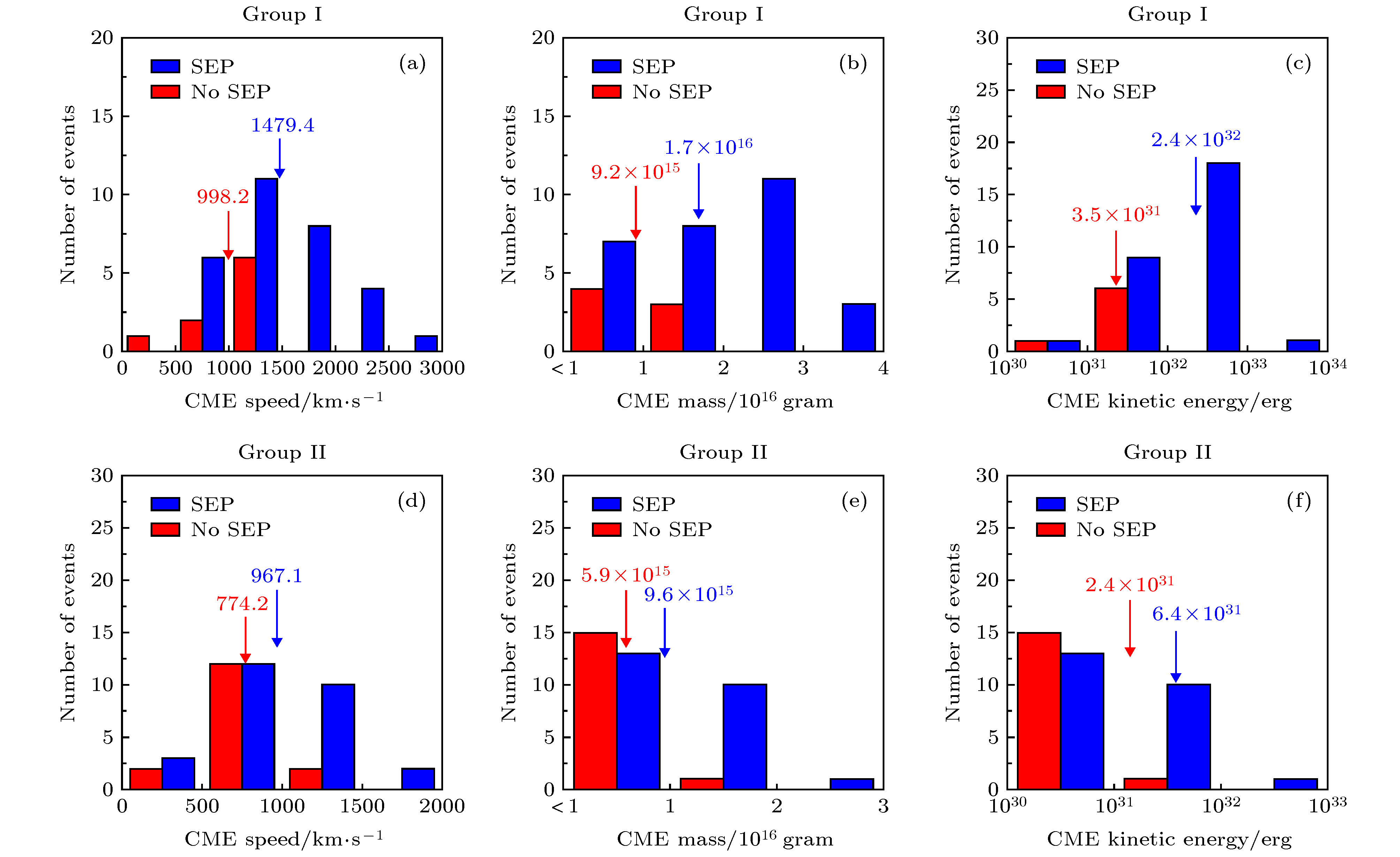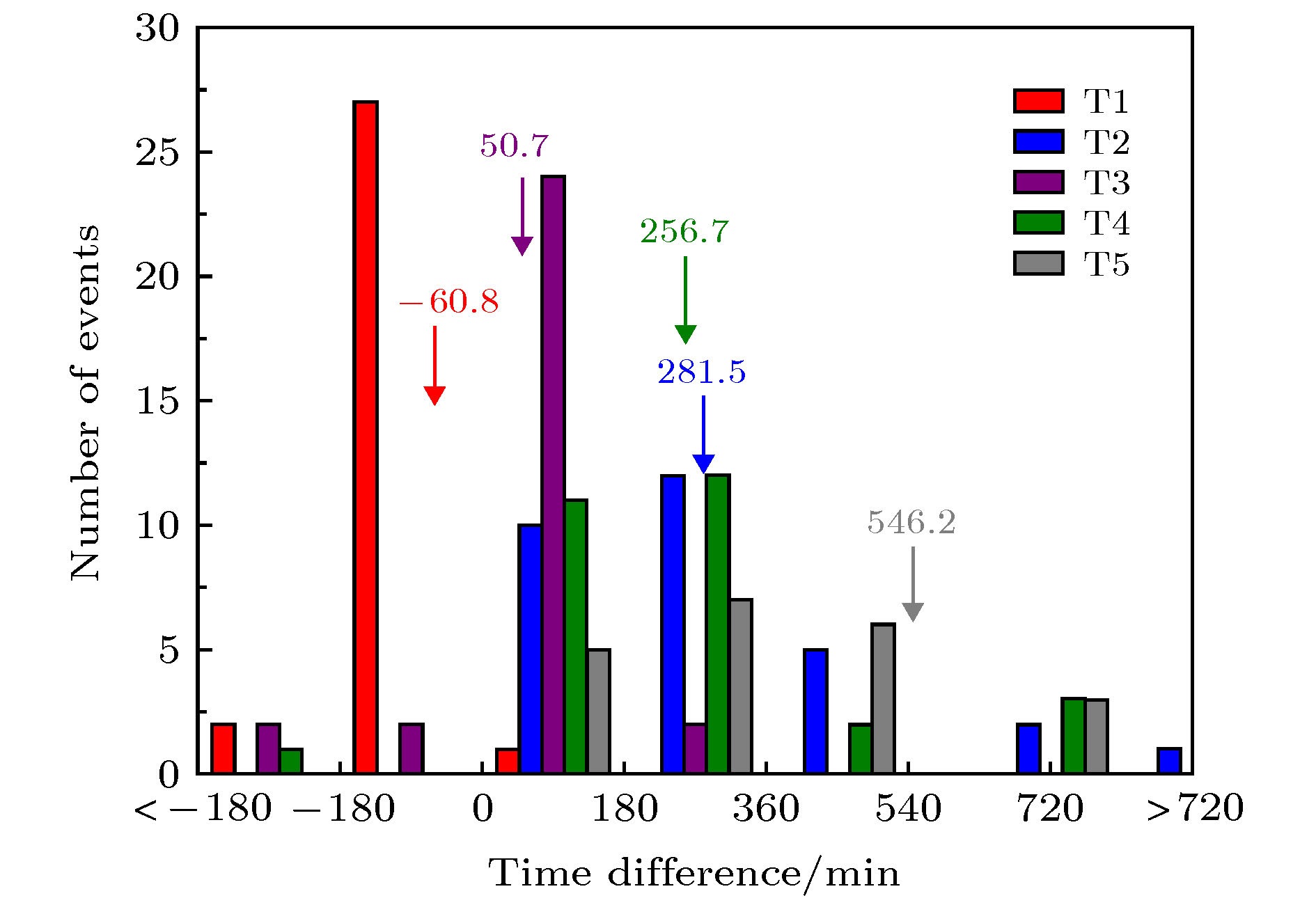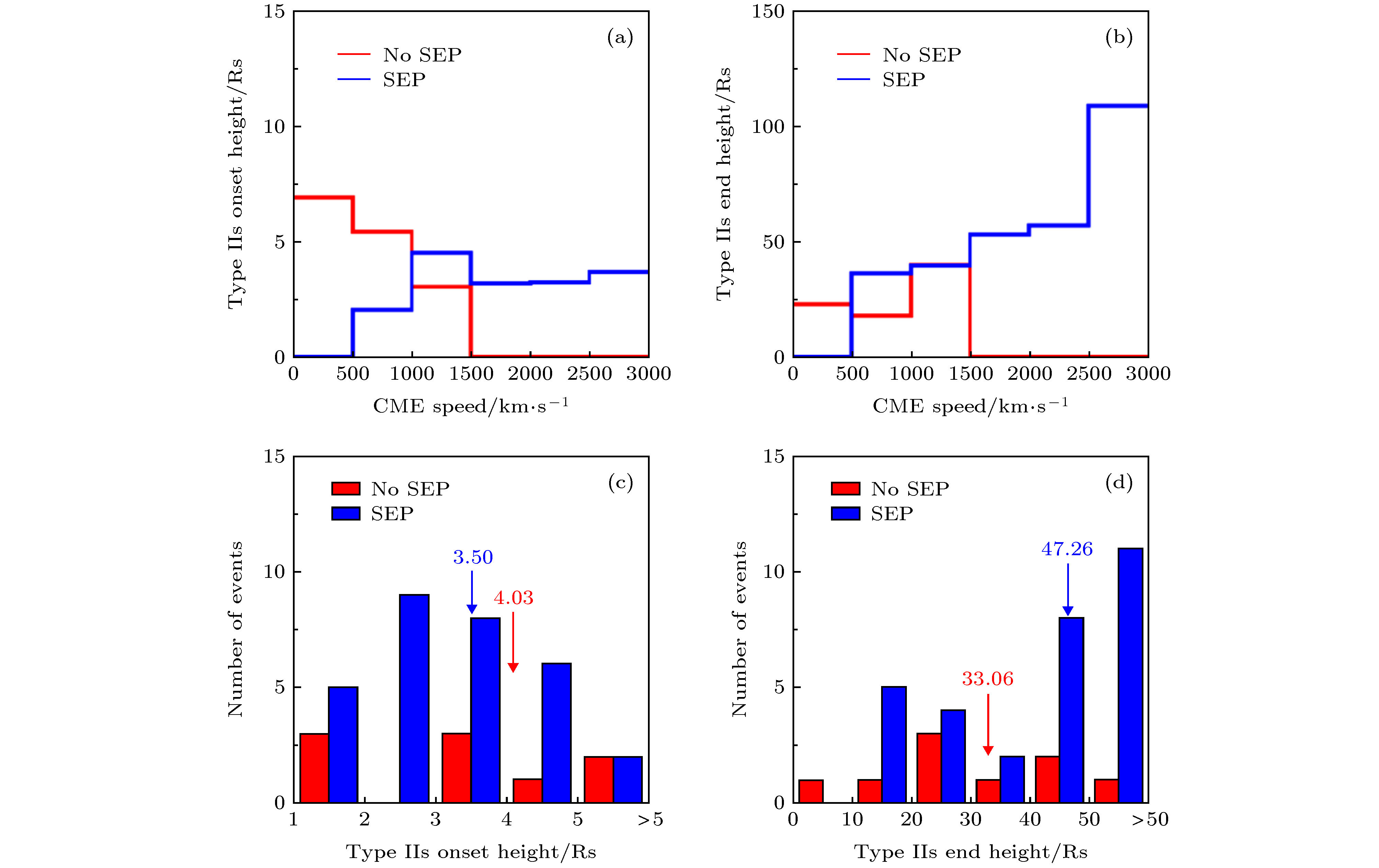-
本文基于Learmonth等地面台站和Wind/WAVES, STEREO/SWAVES等卫星射电观测资料, 筛选了第24个太阳活动周2007年1月至2015年12月期间82个米波-十米百米波(meter-decahectometric, M-DH)、十米-百米波(deca-hectometric, DH)II型射电暴事件, 其中39个射电增强事件和43个非射电增强事件. 研究结果显示: 1)射电增强事件的日冕物质抛射(coronal mass ejection, CME)速度、质量、动能和耀斑等级普遍高于无射电增强事件的; 无论有无射电增强, 产生太阳高能粒子(solar energetic particle, SEP)事件的CME速度、质量和动能均明显大于无SEP事件的CME. 2)特征时间分析显示高能粒子起始释放时间普遍早于射电增强开始时间, 由此表明射电增强不是导致高能粒子事件产生的直接原因. 3)无论有无射电增强, SEP事件伴随的II型射电暴开始高度略低于无SEP事件的; 而II型射电暴结束高度, 产生SEP的事件明显高于无SEP的事件; 伴随射电增强的II型射电暴结束高度显著大于无射电增强事件, 即表明有射电增强事件中的激波更强且可持续到更高高度. 4)当快速CME完全扫过另一个先行CME时, CME相互作用更易产生射电增强, 而是否产生SEP无明显差异. 本文结果表明, 射电增强是CME激波与其他CME相互作用而增强的表现, 增强的激波可能增强粒子加速过程而更易产生大的SEP事件, 但射电增强并非产生SEP事件的直接原因.In this paper, we investigated 82 type-II radio burst events detected by some ground stations Learmonth, YNAO, and BIRS and spacecraft Wind/WAVES, STEREO/WAVES from January 2007 to December 2015. And we identified 39 events associated with radio enhancement and 43 events without enhancement. We found that: 1) The CME velocity, mass, kinetic energy and flare class with respect to type II radio enhancement events were generally higher than that of no enhancement events, and these properties in the solar energetic particle (SEP) events were significantly higher than that no SEP event, regardless of whether radio enhancement or not. 2) As shown in the characteristic time analysis, the initial release time of SEPs is generally earlier than the start time of radio enhancement, so we can the radio enhancement is only as a signature of the shock enhancement rather than the direct generator of SEP events. 3) Whether radio enhancement or not, the onset height of type IIs associated with SEP event is slightly lower than that of event without SEP. For the absence height, the SEP events are significantly higher than the no-SEP events, and that the absence height of enhancement events are also distinctly higher than that non-enhancement events, which reveals that the enhanced CME shock characterized by enhanced radio burst can keep propagating to more higher or further space. 4) When one fast and wide CME fully sweeps over another slow and narrow preceding CME, CME interaction can more easily generate radio enhancement, but no distinctive difference between SEP events and non-SEP events. So the results of this paper reveal that radio enhancement can be regarded as a manifestation of CME shock becoming strong during interacting with other CME, and the enhanced shock can accelerate the particle to generate large SEP events more easily. However, the type II radio enhancement is not the direct producer or causer that generate large SEP event.
-
Keywords:
- type II radio burst /
- radio enhancement /
- solar energetic particle (SEP) /
- shock enhancement
[1] Vršnak B, Cliver E W 2008 Sol. Phys. 253 215
 Google Scholar
Google Scholar
[2] Kahler S W 2001 J. Geophys. Res. 106 20947
 Google Scholar
Google Scholar
[3] Reames D V 1999 Space. Sci. Rev. 90 413
 Google Scholar
Google Scholar
[4] Cliver E W, Kahler S W 2004 Astrophys. J. 605 902
 Google Scholar
Google Scholar
[5] Gopalswamy N, Xie H, Yashiro S, Akiyama S, Mäkelä P, Usoskin I G 2012 Space. Sci. Rev. 171 23
 Google Scholar
Google Scholar
[6] Ding L G, Jiang Y, Li G 2016 Astrophys. J. 818 169
 Google Scholar
Google Scholar
[7] Vainio R, Agueda N, Aran A, Lario D 2007 Space Weather. Springer Netherlands. pp 27–37
[8] Cane H V, von Rosenvinge T T, Cohen C M S, Mewaldt R A 2003 Geophys. Res. Lett. 30 8017
 Google Scholar
Google Scholar
[9] Li C, Tang Y H, Dai Y, Fang C, Vial C 2007 Astron. Astrophys. 472 283
 Google Scholar
Google Scholar
[10] Le G M, Zhang X F 2017 Res. Astron. Astrophys. 17 123
 Google Scholar
Google Scholar
[11] Le G M, Li C, Zhang X F 2017 Res. Astron. Astrophys. 17 73
 Google Scholar
Google Scholar
[12] Wu S S, Qin G 2018 J. Geophys. Res-Space Phys. 123 76
 Google Scholar
Google Scholar
[13] Zhao M X, Le G M, Chi Y T 2018 Res. Astron. Astrophys. 18 74
 Google Scholar
Google Scholar
[14] Zhao M X, Le G M 2020 Res. Astron. Astrophys. 20 37
 Google Scholar
Google Scholar
[15] Mason G M, Mazur J E, Dwyer J R 1999 Astrophys. J. 525 133
 Google Scholar
Google Scholar
[16] Mason G M, Dwyer J R, Mazur J E 2000 Astrophys. J. 545 157
 Google Scholar
Google Scholar
[17] Gopalswamy N, Yashiro S, Michałek G, Kaiser M L, Howard R A, Reames D V, Leske R, von Rosenvinge T 2002 Astrophys. J. 572 103
 Google Scholar
Google Scholar
[18] Gopalswamy N, Yashiro S, Krucker S, Stenborg G, Howard R A 2004 J. Geophys. Res-Space. 109 12105
 Google Scholar
Google Scholar
[19] Li G, Moore R, Mewaldt R A, Zhao L, Labrador A W 2012 Space. Sci. Rev. 171 141
 Google Scholar
Google Scholar
[20] Shen C L, Wang Y M, Ye P Z, Zhao X P, Gui B, Wang S 2007 Astrophys. J. 670 849
 Google Scholar
Google Scholar
[21] Gopalswamy N, Aguilar-Rodriguez E, Yashiro S, Nunes S, Kaiser M L, Howard R A 2005 J. Geophys. Res. 110 12
 Google Scholar
Google Scholar
[22] Winter L M, Ledbetter K 2015 Astrophys. J. 809 105
 Google Scholar
Google Scholar
[23] Gopalswamy N, Yashiro S, Kaiser M L, Howard R A, Bougeret J L 2001 Astrophys. J. 548 91
 Google Scholar
Google Scholar
[24] Ding L G, Li G, Jiang Y, Le G M, Shen C L, Wang Y M, Chen Y, Xu F, Gu B, Zhang Y N 2014 Astrophys. J. 793 35
 Google Scholar
Google Scholar
[25] Ding L G, Wang Z W, Feng L, Li G, Jiang Y 2019 Res. Astron. Astrophys. 19 1
 Google Scholar
Google Scholar
[26] Al-Hamadani F, Pohjolainen S, Valtonen E 2017 Sol. Phys. 292 127
 Google Scholar
Google Scholar
[27] Brueckner G E, Howard R A, Koomen M J, Korendyke C M, Michels D J, Moses J D, Socker D G, Dere K P, Lamy P L, Llebaria A, Bout M V, Schwenn R, Simnett G M, Bedford D K, Eyles C J 1995 Sol. Phys. 162 357
 Google Scholar
Google Scholar
[28] Müller-Mellin R, Kunow H, Fleißner V, Pehlke E, Rode E, Röschmann N, Scharmberg C, Sierks H, Rusznyak P, Mckenna-Lawlor S, Elendt I, Sequeiros J, Meziat D, Sanchez S, Medina J, del Peral L, Witte M, Marsden R, Henrion J 1995 Sol. Phys. 162 483
 Google Scholar
Google Scholar
[29] von Rosenvinge T T, Reames D V, Baker R, Hawk J, Nolan J T, Ryan L, Shuman S, Wortman K A, Mewaldt R A, Cummings A C, Cook W R, Labrador A W, Leske R A, Wiedenbeck M E 2008 Space. Sci. Rev. 136 391
 Google Scholar
Google Scholar
[30] 王智伟, 丁留贯, 周坤论, 乐贵明 2018 地球 61 3515
 Google Scholar
Google Scholar
Wang Z W, Ding L G, Zhou K L, Le G M 2018 Chin. J. Geophys. 61 3515
 Google Scholar
Google Scholar
[31] Tylka A J, Cohen C M S, Dietrich W F, Krucker S, McGuire R E, Mewaldt R A, Ng C K, Reames D V, Share G H 2003 The 28 th International Cosmic Ray Conference 6 3305
[32] Kim R S, Cho K S, Lee J, Bong S C, Park Y D 2014 J. Geophys. Res-Space. 119 9419
 Google Scholar
Google Scholar
[33] 乐贵明, 唐玉华, 韩延本 2007 科学通报 52 2461
 Google Scholar
Google Scholar
Le G M, Tang Y H, Han Y B 2007 Chin. Sci. Bull. 52 2461
 Google Scholar
Google Scholar
[34] Newkirk G Jr 1961 Astrophys. J. 133 983
 Google Scholar
Google Scholar
[35] Vršnak B, Magdalenić J, Zlobec P 2004 Astron. Astrophys. 413 753
 Google Scholar
Google Scholar
[36] Saito K, Poland A I, Munro R H 1977 Sol. Phys. 55 121
 Google Scholar
Google Scholar
[37] Gopalswamy N, S Yashiro 2011 Astrophys. J. 736 17
 Google Scholar
Google Scholar
[38] Mäkelä P, Gopalswamy N, Akiyama S, Xie H, Yashiro S 2015 Astrophys. J. 806 13
 Google Scholar
Google Scholar
[39] Kocharov L, Pohjolainen S, Mishev A, Reiner M J, Lee J, Laitinen T, Didkovsky L V, Pizzo V J, Kim R, Klassen A, Karlicky M, Cho K S, Gary D E, Usoskin I, Valtonen E, Vainio R 2017 Astrophys. J. 839 79
 Google Scholar
Google Scholar
[40] Temmer M, Vršnak B, Rollett T, Bein B, Koning D, Liu Y, Bosman E, Davies J A, Most C, Zic T, Veronig A M, Bothmer V, Harrison R, Nitta N, Bisi M, Flor O, Eastwood J, Odstrcil D, Forsyth R 2012 Astrophys. J. 749 57
 Google Scholar
Google Scholar
[41] Ding L G, Jiang Y, Zhao L L, Li G 2013 Astrophys. J. 763 30
 Google Scholar
Google Scholar
[42] Martínez Oliveros J C, Raftery C L, Bain H M, Liu Y, Krupar V, Bale S, Krucker S 2012 Astrophys. J. 748 66
 Google Scholar
Google Scholar
[43] 周坤论, 丁留贯, 王智伟, 封莉 2019 68 13
 Google Scholar
Google Scholar
Zhou K L, Ding L G, Wang Z W, Feng L 2019 Acta Phys. Sin. 68 13
 Google Scholar
Google Scholar
[44] Bemporad A, Mancuso S 2013 J. Adv. Res. 4 287
 Google Scholar
Google Scholar
[45] Sheeley Jr N R, Hakala W N, Wang Y M 2000 J. Geophys. Res. 105 5081
 Google Scholar
Google Scholar
[46] Vourlidas A, Wu S T, Wang A H, Subramanian P, Howard R A 2003 J. Adv. Res. 598 1392
 Google Scholar
Google Scholar
[47] Cho K S, Lee J, Moon Y J, Dryer M, Bong S C, Kim Y H, Park Y D 2007 Astron. Astrophys. 461 1121
 Google Scholar
Google Scholar
[48] Cho K S, Bong S C, Kim Y H, Moon Y J, Dryer M, Shanmugaraju A, Lee J, Park Y D 2008 Astron. Astrophys. 491 873
 Google Scholar
Google Scholar
[49] Feng S W, Chen Y, Kong X L, Li G, Song H Q, Feng X S, Ying Liu 2012 Astrophys. J. 753 21
 Google Scholar
Google Scholar
-
图 5 以SEP事件起始时刻作为参考点0, 各时间点与参考点之差的统计直方图. II型射电暴起始(T1红色)和结束时刻(T2蓝色)、射电增强起始(T3紫色)和结束时刻(T4绿色)、SEP峰值时刻(T5灰色)
Fig. 5. Uses the starting moment of the SEP events as the reference point (0), histogram of the difference between type II radio burst start /stop time(T1/T2), radio enhancement start/stop(T3/T4), SEP stop time(T5) and the reference point respectively.
-
[1] Vršnak B, Cliver E W 2008 Sol. Phys. 253 215
 Google Scholar
Google Scholar
[2] Kahler S W 2001 J. Geophys. Res. 106 20947
 Google Scholar
Google Scholar
[3] Reames D V 1999 Space. Sci. Rev. 90 413
 Google Scholar
Google Scholar
[4] Cliver E W, Kahler S W 2004 Astrophys. J. 605 902
 Google Scholar
Google Scholar
[5] Gopalswamy N, Xie H, Yashiro S, Akiyama S, Mäkelä P, Usoskin I G 2012 Space. Sci. Rev. 171 23
 Google Scholar
Google Scholar
[6] Ding L G, Jiang Y, Li G 2016 Astrophys. J. 818 169
 Google Scholar
Google Scholar
[7] Vainio R, Agueda N, Aran A, Lario D 2007 Space Weather. Springer Netherlands. pp 27–37
[8] Cane H V, von Rosenvinge T T, Cohen C M S, Mewaldt R A 2003 Geophys. Res. Lett. 30 8017
 Google Scholar
Google Scholar
[9] Li C, Tang Y H, Dai Y, Fang C, Vial C 2007 Astron. Astrophys. 472 283
 Google Scholar
Google Scholar
[10] Le G M, Zhang X F 2017 Res. Astron. Astrophys. 17 123
 Google Scholar
Google Scholar
[11] Le G M, Li C, Zhang X F 2017 Res. Astron. Astrophys. 17 73
 Google Scholar
Google Scholar
[12] Wu S S, Qin G 2018 J. Geophys. Res-Space Phys. 123 76
 Google Scholar
Google Scholar
[13] Zhao M X, Le G M, Chi Y T 2018 Res. Astron. Astrophys. 18 74
 Google Scholar
Google Scholar
[14] Zhao M X, Le G M 2020 Res. Astron. Astrophys. 20 37
 Google Scholar
Google Scholar
[15] Mason G M, Mazur J E, Dwyer J R 1999 Astrophys. J. 525 133
 Google Scholar
Google Scholar
[16] Mason G M, Dwyer J R, Mazur J E 2000 Astrophys. J. 545 157
 Google Scholar
Google Scholar
[17] Gopalswamy N, Yashiro S, Michałek G, Kaiser M L, Howard R A, Reames D V, Leske R, von Rosenvinge T 2002 Astrophys. J. 572 103
 Google Scholar
Google Scholar
[18] Gopalswamy N, Yashiro S, Krucker S, Stenborg G, Howard R A 2004 J. Geophys. Res-Space. 109 12105
 Google Scholar
Google Scholar
[19] Li G, Moore R, Mewaldt R A, Zhao L, Labrador A W 2012 Space. Sci. Rev. 171 141
 Google Scholar
Google Scholar
[20] Shen C L, Wang Y M, Ye P Z, Zhao X P, Gui B, Wang S 2007 Astrophys. J. 670 849
 Google Scholar
Google Scholar
[21] Gopalswamy N, Aguilar-Rodriguez E, Yashiro S, Nunes S, Kaiser M L, Howard R A 2005 J. Geophys. Res. 110 12
 Google Scholar
Google Scholar
[22] Winter L M, Ledbetter K 2015 Astrophys. J. 809 105
 Google Scholar
Google Scholar
[23] Gopalswamy N, Yashiro S, Kaiser M L, Howard R A, Bougeret J L 2001 Astrophys. J. 548 91
 Google Scholar
Google Scholar
[24] Ding L G, Li G, Jiang Y, Le G M, Shen C L, Wang Y M, Chen Y, Xu F, Gu B, Zhang Y N 2014 Astrophys. J. 793 35
 Google Scholar
Google Scholar
[25] Ding L G, Wang Z W, Feng L, Li G, Jiang Y 2019 Res. Astron. Astrophys. 19 1
 Google Scholar
Google Scholar
[26] Al-Hamadani F, Pohjolainen S, Valtonen E 2017 Sol. Phys. 292 127
 Google Scholar
Google Scholar
[27] Brueckner G E, Howard R A, Koomen M J, Korendyke C M, Michels D J, Moses J D, Socker D G, Dere K P, Lamy P L, Llebaria A, Bout M V, Schwenn R, Simnett G M, Bedford D K, Eyles C J 1995 Sol. Phys. 162 357
 Google Scholar
Google Scholar
[28] Müller-Mellin R, Kunow H, Fleißner V, Pehlke E, Rode E, Röschmann N, Scharmberg C, Sierks H, Rusznyak P, Mckenna-Lawlor S, Elendt I, Sequeiros J, Meziat D, Sanchez S, Medina J, del Peral L, Witte M, Marsden R, Henrion J 1995 Sol. Phys. 162 483
 Google Scholar
Google Scholar
[29] von Rosenvinge T T, Reames D V, Baker R, Hawk J, Nolan J T, Ryan L, Shuman S, Wortman K A, Mewaldt R A, Cummings A C, Cook W R, Labrador A W, Leske R A, Wiedenbeck M E 2008 Space. Sci. Rev. 136 391
 Google Scholar
Google Scholar
[30] 王智伟, 丁留贯, 周坤论, 乐贵明 2018 地球 61 3515
 Google Scholar
Google Scholar
Wang Z W, Ding L G, Zhou K L, Le G M 2018 Chin. J. Geophys. 61 3515
 Google Scholar
Google Scholar
[31] Tylka A J, Cohen C M S, Dietrich W F, Krucker S, McGuire R E, Mewaldt R A, Ng C K, Reames D V, Share G H 2003 The 28 th International Cosmic Ray Conference 6 3305
[32] Kim R S, Cho K S, Lee J, Bong S C, Park Y D 2014 J. Geophys. Res-Space. 119 9419
 Google Scholar
Google Scholar
[33] 乐贵明, 唐玉华, 韩延本 2007 科学通报 52 2461
 Google Scholar
Google Scholar
Le G M, Tang Y H, Han Y B 2007 Chin. Sci. Bull. 52 2461
 Google Scholar
Google Scholar
[34] Newkirk G Jr 1961 Astrophys. J. 133 983
 Google Scholar
Google Scholar
[35] Vršnak B, Magdalenić J, Zlobec P 2004 Astron. Astrophys. 413 753
 Google Scholar
Google Scholar
[36] Saito K, Poland A I, Munro R H 1977 Sol. Phys. 55 121
 Google Scholar
Google Scholar
[37] Gopalswamy N, S Yashiro 2011 Astrophys. J. 736 17
 Google Scholar
Google Scholar
[38] Mäkelä P, Gopalswamy N, Akiyama S, Xie H, Yashiro S 2015 Astrophys. J. 806 13
 Google Scholar
Google Scholar
[39] Kocharov L, Pohjolainen S, Mishev A, Reiner M J, Lee J, Laitinen T, Didkovsky L V, Pizzo V J, Kim R, Klassen A, Karlicky M, Cho K S, Gary D E, Usoskin I, Valtonen E, Vainio R 2017 Astrophys. J. 839 79
 Google Scholar
Google Scholar
[40] Temmer M, Vršnak B, Rollett T, Bein B, Koning D, Liu Y, Bosman E, Davies J A, Most C, Zic T, Veronig A M, Bothmer V, Harrison R, Nitta N, Bisi M, Flor O, Eastwood J, Odstrcil D, Forsyth R 2012 Astrophys. J. 749 57
 Google Scholar
Google Scholar
[41] Ding L G, Jiang Y, Zhao L L, Li G 2013 Astrophys. J. 763 30
 Google Scholar
Google Scholar
[42] Martínez Oliveros J C, Raftery C L, Bain H M, Liu Y, Krupar V, Bale S, Krucker S 2012 Astrophys. J. 748 66
 Google Scholar
Google Scholar
[43] 周坤论, 丁留贯, 王智伟, 封莉 2019 68 13
 Google Scholar
Google Scholar
Zhou K L, Ding L G, Wang Z W, Feng L 2019 Acta Phys. Sin. 68 13
 Google Scholar
Google Scholar
[44] Bemporad A, Mancuso S 2013 J. Adv. Res. 4 287
 Google Scholar
Google Scholar
[45] Sheeley Jr N R, Hakala W N, Wang Y M 2000 J. Geophys. Res. 105 5081
 Google Scholar
Google Scholar
[46] Vourlidas A, Wu S T, Wang A H, Subramanian P, Howard R A 2003 J. Adv. Res. 598 1392
 Google Scholar
Google Scholar
[47] Cho K S, Lee J, Moon Y J, Dryer M, Bong S C, Kim Y H, Park Y D 2007 Astron. Astrophys. 461 1121
 Google Scholar
Google Scholar
[48] Cho K S, Bong S C, Kim Y H, Moon Y J, Dryer M, Shanmugaraju A, Lee J, Park Y D 2008 Astron. Astrophys. 491 873
 Google Scholar
Google Scholar
[49] Feng S W, Chen Y, Kong X L, Li G, Song H Q, Feng X S, Ying Liu 2012 Astrophys. J. 753 21
 Google Scholar
Google Scholar
计量
- 文章访问数: 7818
- PDF下载量: 74
- 被引次数: 0














 下载:
下载:








